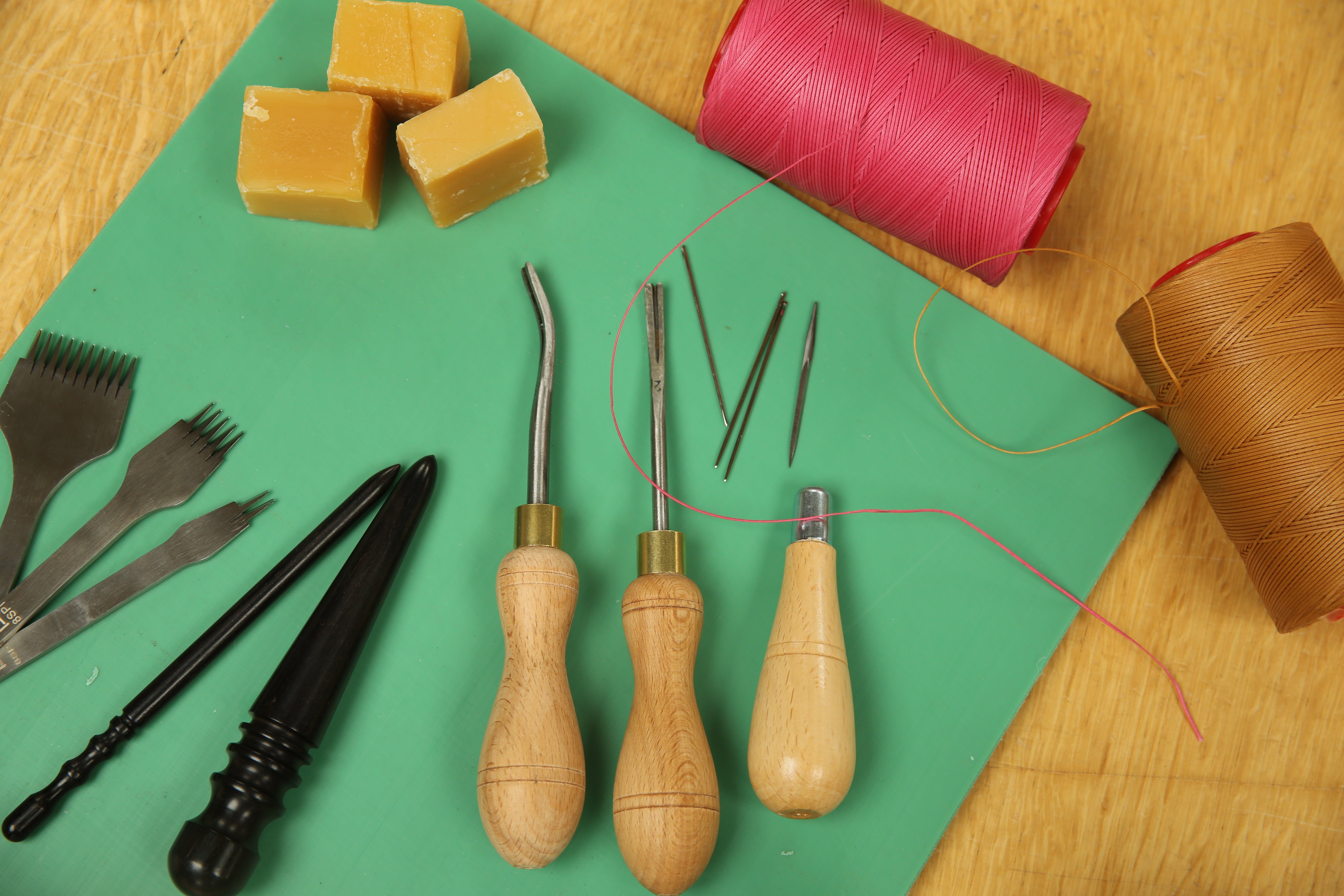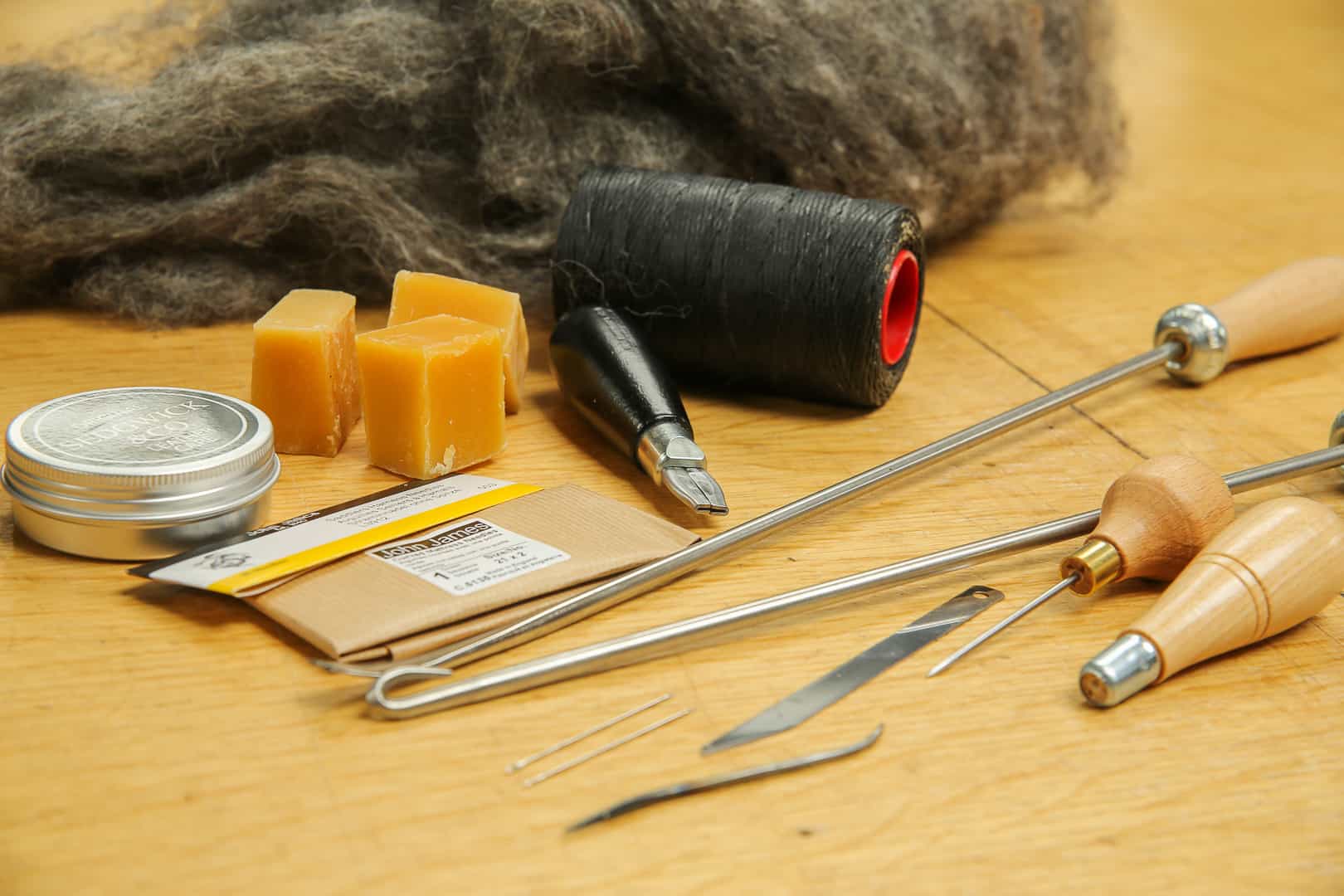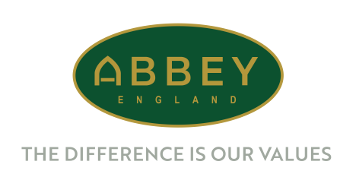A BEGINNERS' GUIDE TO LEATHER
A Guide to Leather Hides:
the best type of leather for every leather project
At Abbey we stock a range of leathers from bridle butts and mini butts to russet shoulders and greased pigskins. Each type of leather has its own characteristics and is suited to different purposes. If you are new to leatherworking you may find the choice a little daunting. If so you’ve come to the right place. At Abbey, we want you to be confident with your purchases, so we’ve put together a short guide, in collaboration with Jo Heard from JH Leather, recommending the best type of leather for each leather project.
_________________________________________________
OUR CONTRIBUTOR
BAGS
Top Choice: Sedgwick 1900 Collection, 2.3mm
The Sedgwick 1900 Collection is a lovely looking leather with everything on show, available in a range of colours. The 2.3mm thickness is perfect for making a whole range of bags.More specifically, if you are looking to make a cartridge bag, we recommend using a vegetable tanned shoulder that is around 2.5mm thick. We love the Sedgwick 1900 collection or, if you are after something a bit different, the Sedgwick’s bag hide would be a good option in the wheat print option.
Login now or register to see our prices.
Images kindly provided by Jo Heard, JH Leather
BELTS
Top Choice: Sedgwick mini butts / bridle butts
Our Sedgwick mini butts are perfect for making belts. Shorter than bridle butts, traditional belt makers use these mini butts as they tend to be the correct length. This means you will end up with less wastage and you won’t have the slightly stretchy part of the shoulder at one end. If you want to make a longer belt, then the bridle butt is prefect. We stock the Sedgwick’s range of bridle butts, as well as a range of John Whites bridle butt and Italian bridle butts.We do not advise using shoulder leather for belts but, if you would like a non-greased option, you may use the Sedgwick 1900 Collection in 3.2 mm thickness. Shoulder leather should only be used in 3mm thickness or above when making belts.
Login now or register to see our prices.
DOG COLLARS
Top Choice: Bridle butt leather, varying thickness
The type of leather you use for making dog collars will depend on the look of your final product. The weight and thickness of the leather will also depend on the type of dog you collar is designed for. For example, a 2 mm leather would not be suitable for a larger dog and a 4 mm leather would not be suitable for a small dog. Due to its strength, the best leather to use is bridle butt leather. The black, Australian nut, dark Havana, hazel or conker colour options are more resistant to water spot damage and are less likely to fade, unlike red, green, blue, light Havana and London tan coloured leathers which are not recommended. Furthermore, our mini bridle butts are a good option if you do not require the additional length of a standard butt.DOG LEADS
Top Choice: Bridle butt leather
For dog leads, bridle butts are best as you don’t want them to stretch.If you are looking to make a longer lead, you may require bridle back leather.
WALLETS
Top Choice: Vegetable tanned pig skin, 1mm – 1.5mm
For wallet making, you ideally want your leather to be around 1mm – 1.5mm thick.We recommend using vegetable tanned pig skin, which has a beautiful texture to it. Our top choice is the greased pig skin as it has a lovely soft feel.
GET YOUR TOOL FIX
At Abbey we love to support our local makers and hobbyists. With this in mind, we partnered up with Jo to make this video on leatherwork tools for beginners. It will help to get you started with the best tools to use on your newly selected leather.
MORE GUIDES
_________________________________________________
Hover image
YOUR GUIDE TO A LEATHERWORKING KIT

YOUR GUIDE TO A LEATHERWORKING KIT
Hover image

YOUR GUIDE TO FLOCKING KITS
A BEGINNERS' GUIDE TO LEATHER
A Guide to Leather Hides:
the best type of leather for every leather project
At Abbey we stock a range of leathers from bridle butts and mini butts to russet shoulders and greased pigskins. Each type of leather has its own characteristics and is suited to different purposes. If you are new to leatherworking you may find the choice a little daunting. If so you’ve come to the right place. At Abbey, we want you to be confident with your purchases, so we’ve put together a short guide, in collaboration with Jo Heard from JH Leather, recommending the best type of leather for each leather project.
_________________________________________________
OUR CONTRIBUTOR
BAGS
Top Choice: Sedgwick 1900 Collection, 2.3mm
The Sedgwick 1900 Collection is a lovely looking leather with everything on show, available in a range of colours. The 2.3mm thickness is perfect for making a whole range of bags.More specifically, if you are looking to make a cartridge bag, we recommend using a vegetable tanned shoulder that is around 2.5mm thick. We love the Sedgwick 1900 collection or, if you are after something a bit different, the Sedgwick’s bag hide would be a good option in the wheat print option.
Login now or register to see our prices.
Images kindly provided by Jo Heard, JH Leather
BELTS
Top Choice: Sedgwick mini butts / bridle butts
Our Sedgwick mini butts are perfect for making belts. Shorter than bridle butts, traditional belt makers use these mini butts as they tend to be the correct length. This means you will end up with less wastage and you won’t have the slightly stretchy part of the shoulder at one end. If you want to make a longer belt, then the bridle butt is prefect. We stock the Sedgwick’s range of bridle butts, as well as a range of John Whites bridle butt and Italian bridle butts.We do not advise using shoulder leather for belts but, if you would like a non-greased option, you may use the Sedgwick 1900 Collection in 3.2 mm thickness. Shoulder leather should only be used in 3mm thickness or above when making belts.
Login now or register to see our prices.
DOG COLLARS
Top Choice: Bridle butt leather, varying thickness
The type of leather you use for making dog collars will depend on the look of your final product. The weight and thickness of the leather will also depend on the type of dog you collar is designed for. For example, a 2 mm leather would not be suitable for a larger dog and a 4 mm leather would not be suitable for a small dog. Due to its strength, the best leather to use is bridle butt leather. The black, Australian nut, dark Havana, hazel or conker colour options are more resistant to water spot damage and are less likely to fade, unlike red, green, blue, light Havana and London tan coloured leathers which are not recommended. Furthermore, our mini bridle butts are a good option if you do not require the additional length of a standard butt.DOG LEADS
Top Choice: Bridle butt leather
For dog leads, bridle butts are best as you don’t want them to stretch.If you are looking to make a longer lead, you may require bridle back leather.
WALLETS
Top Choice: Vegetable tanned pig skin, 1mm – 1.5mm
For wallet making, you ideally want your leather to be around 1mm – 1.5mm thick.We recommend using vegetable tanned pig skin, which has a beautiful texture to it. Our top choice is the greased pig skin as it has a lovely soft feel.
GET YOUR TOOL FIX
At Abbey we love to support our local makers and hobbyists. With this in mind, we partnered up with Jo to make this video on leatherwork tools for beginners. It will help to get you started with the best tools to use on your newly selected leather.
MORE GUIDES
_________________________________________________
Hover image
YOUR GUIDE TO A LEATHERWORKING KIT

YOUR GUIDE TO A LEATHERWORKING KIT
Hover image




 Deutsch (Deutschland)
Deutsch (Deutschland) Español (España)
Español (España) Français (France)
Français (France) Italiano (Italia)
Italiano (Italia)
